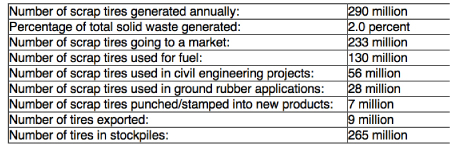by Sally Cummings
I have a few tires at home. How can I recycle them?
You may be able to return surplus tires to either a tire retailer or a local recycling facility that accepts tires. Be sure to confirm that the facility accepts tires for recycling and check for quantity and size limitations. Some local municipalities will also periodically conduct “tire amnesty days” when any local citizen can bring a limited number of tires to a drop-off site free of charge. For more information, or if you have large numbers of scrap tires, contact your local solid waste management agency.
Tire-Derived Aggregate in Civil Engineering Applications
Highway Sound Barriers – Many states are turning to absorptive sound barriers—structures that soak up sound—to reduce highway noise. The “Whisper Wall” used in Northern Virginia, starts as a mixture of concrete aggregate, cement, water, and small pieces of shredded rubber from scrap tires. The wall deflects sound waves among its nooks and crannies until they lose energy.
Athletic and Recreational Applications – Several brands of resilient playground rubber surfacing material are being made from recycled tires and sold at major retailers across the US. The material can absorb much of the impact from falls providing added safety to children. This material can also be used as a mulch replacement in medians or decorative areas. Athletic and recreational applications are a fast growing market for ground rubber. An estimated 80 million pounds of scrap tire rubber were used in 2001 for athletic/field turf applications (50 million pounds)—above or below the ground—and as loose cover (30 million pounds).
Railroad Ties – Highly durable, rubber-encased railroad ties are being produced using scrap tires. These railroad ties have a steel-beam core filled with concrete that is then encased in 80 pounds of ground-up scrap tires and discarded plastic bottles, held together with a special binder or glue. These railroad ties are over 200% stronger than creosote-soaked wooden ties, enabling railroads to use fewer ties per mile. Moreover, rubber-encased railroad ties could last 60 to 90 years versus 5 to 30 years for wood.
Asphalt Rubber
Asphalt rubber is the largest single market for ground rubber, consuming an estimated 220 million pounds, or approximately 12 million tires. California and Arizona use the most asphalt rubber in highway construction (over 80% of asphalt rubber utilized). Florida is the next largest user.
Ground tire rubber can be blended with asphalt to beneficially modify the properties of the asphalt in highway construction. Size-reduced scrap tire rubber can be used either as part of the asphalt rubber binder (alao known as, asphalt rubber), seal coat, cap seal spray or joint and crack sealant, or as an aggregate substitution (rubber modified asphalt concrete).
Benefits of using asphalt rubber include:
Longer lasting road surfaces; Reduced road maintenance; Cost effectiveness over the long term; Lower road noise; and Shorter breaking distances. Asphalt rubber is being used in greater amounts by state Departments of Transportation. Arizona and Florida have been leaders in asphalt rubber utilization. Texas and Nebraska are currently using greater amounts of asphalt rubber. South Carolina is also pursuing utilization of asphalt rubber in county and state roads. Other states that have studied and/or used rubberized asphalt include New York and New Mexico.
What is the current status of tire recycling and disposal in the US*?

Published in March/April 2014 Save the Pine Bush Newsletter